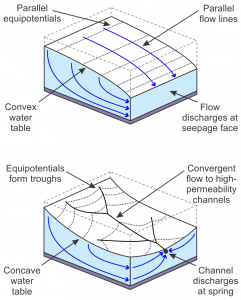
Self-organization is a process where local interactions in an initially disordered system result in the emergence or an overall order to the system. Self-organization is an important process in bedrock aquifers. Dissolution is the principal form of weathering in aquifers, and in a bedrock aquifer with fractures the most dissolution occurs where there is the most flow. This increases the apertures in these fractures which in turn increases the flow, and this positive feedback process creates a high-permeability channel network. Self-organization occurs not only in carbonate aquifers, but also in silicate aquifers. Self-organization results in channel networks with a dendritic structure that discharge to springs rather than seepage faces, as shown in the figure. Sometimes feedback processes can enlarge channels so much that flow becomes turbulent, especially in downgradient areas close to springs.